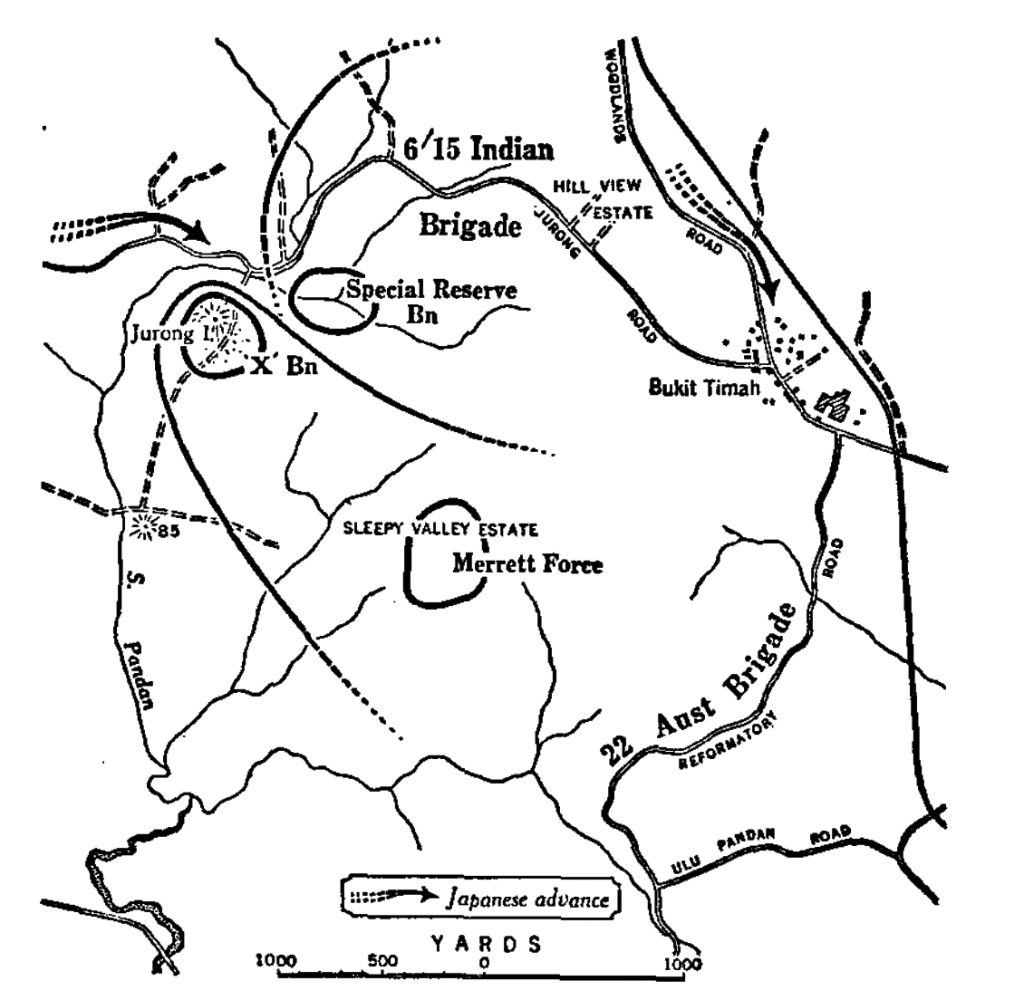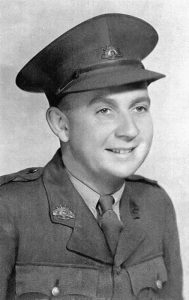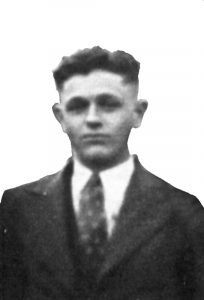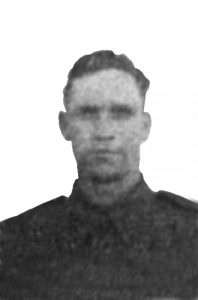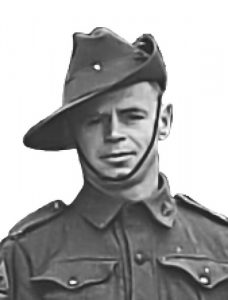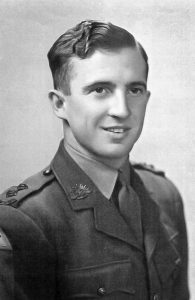‘E’ COMPANY, SPECIAL RESERVE BATTALION (formed 7/2/1942) More than half of this Coy lost their lives between 10 – 12 Feb 1942 SW Bukit Timah.
The battle for Bukit Timah resulted in the largest loss of lives at any one time anywhere throughout this 7 day war.
Bukit Timah Hill, the highest point on the island, provided a commanding view over Singapore City that could be used to direct artillery fire. Most crucial, however, was Bukit Timah’s importance to the local water supply, as both MacRitchie and Pierce reservoirs are located in the area. Colonel Masanobu Tsuji, Japanese staff officer who planned the attack on Singapore, noted that the loss of these reservoirs would be fatal to the British.
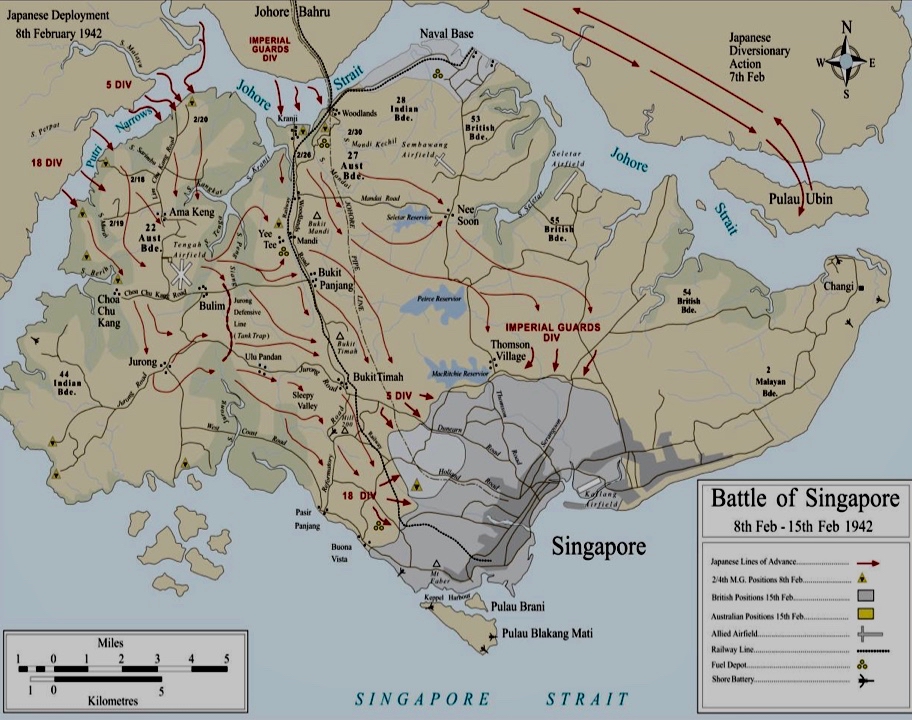
Above: Singapore map shows Sleepy Valley, Bukit Timah
‘The Special Reserve Battalion was comprised of two companies ‘A’ and ‘B’ made up of Australian Army Service Corps personnel and ‘E’ Company. ‘E’ Company was formed from the reinforcements for 2/4th who embarked on ‘Aquitania’ 16th January 1942.’
Please read efforts to recover 2/4th bodies Dec 1942
The 2/4th Battalion arrived Singapore 25 Jan 1942 and were trucked to Woodlands Camp, north on Singapore Island. They were in Singapore to reinforce the depleted Australian 8th Division who combined with British Divisions, had been fighting and retreating from the Japanese from south Thailand through Malaya since 8th December 1941.
The men of 2/4th found themselves in a war zone in a new and very foreign culture. The sights, smells and sounds of war in tropical Singapore – facing a massive invasion.
At 8.15am, 31 January 1942 the Causeway linking Malaya to Singapore was blown.
It was now a race to prepare the defence of Singapore’s coastline – that is correct! Those in charge had wasted the precious previous two months and had done nothing.
Singapore proved to be a hive of too many chiefs.
Decisions and plans were delayed. Confusion reigned. Troops referred to Malayan Command as ‘Confusion Castle’.
There should have been one commander to make decisions. Percival was not the most suitable man for his job. He answered to Wavell sitting in his office in Java. Singapore became home to those British retreating from the front line – CO’s of Royal Navy, Air Force, etc. From Hong Kong. The GG of Singapore Sir Shenton Thomas still had much to say as did Australia’s Gordon Bennett, Churchill had much to say from England.
Singapore had been left without tanks, planes and ships.
There were 85,000 Allied soldiers on Singapore Island – however of that number, the vast majority were not combat troops. That is to say they were involved in administration and support.
Commanding Officer, Major Bert Saggers.
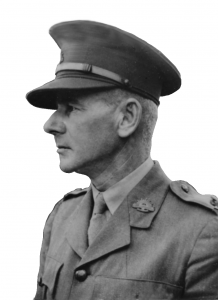
At 5.30pm 6 Feb 1942 Lt, Col Anketell informed Saggers, then CO of ‘A’ Company, he was to command a composite Battalion from AASC and Ordinance Units plus 2/4th reinforcements ‘E’ Coy.
Anketell and Saggers immediately drove to HQ where his appointment was confirmed. He was instructed to report to Col. Stahle, CO Ordinance Corps. The new unit was to be known as SPECIAL RESERVE BATTALION.
AASC personnel had already been organised into two infantry companies. ‘A’ Coy commanded by Capt. Hiddleston and ‘B’ Coy by Capt Millner. Both were AASC officers.
The Third Company comprised 2/4th’s Reinforcement Company – ‘E’ Company originally commanded by Lt. Harry de Moulin. The first two companies were 184 strong and the third ‘E’ Coy was only 88 strong – but in possession of 11 sub-machine guns. ‘A’ and ‘B’ companies had no sub-machine guns and 30% did not even have bayonets.
The SRB was in the main (according to Saggers) under trained and under-equipped, but was not to be under-valued.
Whilst de Moulin commanded the Company with Charlie Odgers his 2 i/c (de Moulin was very young and understandably later buckled under stress.) Harry Green, Jimmy Till and Harry Mazza were the Platoon commanders. Several days later, Saggers appointed Vic Warhurst (who had joined 2/4th at Darwin) as Company Commander and Harry de Moulin his 2 i/c.
Major Saggers also took with him to SRB WX8867 Corporal George William Taylor – to drive for him. We learn this from his Sagger’s War Diary.
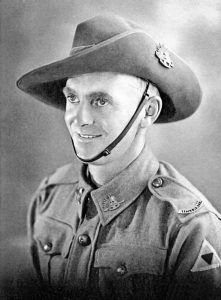
Taylor would have rejoined his Unit. He later left with ‘E’ Force Borneo. George died of Malaria on 2 March 1945 at Sandakan.
Please read all names of 2/4th’s ‘E’ Company, SRB
Below is a brief description by ‘E’ Company CO Major Bert Saggers. Also we have a more detailed description by reinforcement Wally Holding detailing their time from Northam – boarding ‘Aquitania’ & sailing to Singapore – Battle of Singapore.
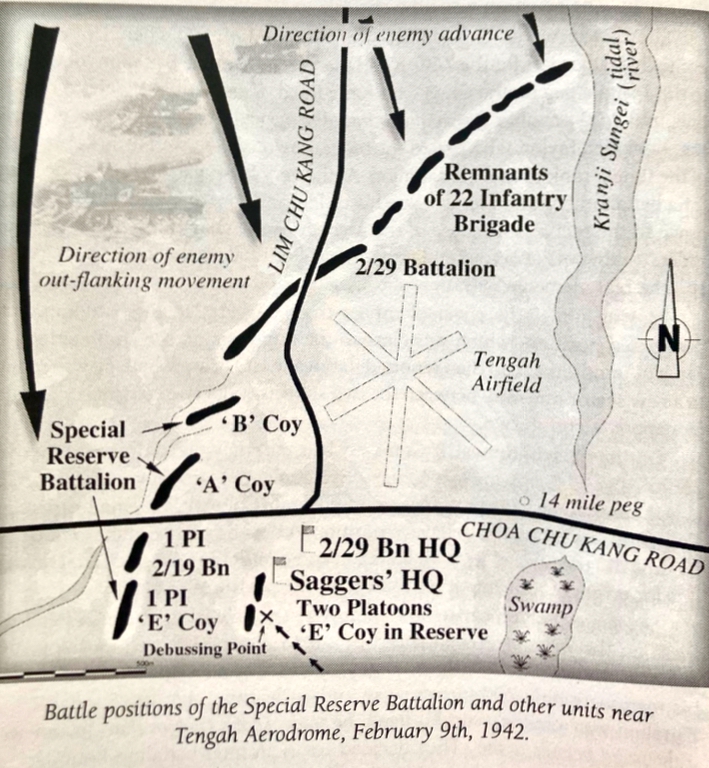
8th Feb 1942
At 4pm on 9th February Saggers was ordered to Divisional Command and presented to General Bennett. Bennett informed Saggers the Japanese had landed on north west coast and ordered SRB to a position on the Lim Chu Kang Road – westward in the direction of the Choa Chu Kang Village. Three-ton lorries were to be provided and the move to take place immediately.
During the night there had been sporadic shelling but with the arrival of dawn and the light, the strafing commenced.
9th February
(because of the unsanctioned withdrawal of the Australian 27th Brigade by Brigadier Maxwell, the Japanese Guards recovered and drove a wedge between the defending troops, leaving he road to Bukit Timah dangerously open.)
With the arrival of the trucks early next morning came the welcome arrival of 150 bayonets which were immediately issued.
‘B’ Coy was ordered to debus first, followed by ‘A’ Coy which Saggers led in his own vehicle. The map reading proved very difficult – the road they were following took them through thickly planted rubber trees and was not clearly defined. While the rubber trees provided cover from an arial assault, the Japanese found their target with shelling. About a kilometre and half in, ‘A’ Coy came across the rear vehicle of ‘B’ Coy – stationery and abandoned.
Saggers found all the ‘B’ Coy men disbursed amongst the rubber plantation! Saggers later wrote in his diary that he became extremely angry, even swore, and ordered all the men into their vehicles and start moving. They were not to halt again for any reason until they reached their designated debussing point.
Fortunately there were no casualties but the noise of the battle was most evident and very close to their debussing point. While the troops moved into position, Saggers established a HQ in an isolated and vacated native hut.
Saggers moved forward to Choa Chu Kang Road to meet with Brigadier Taylor, 22nd Brigade who indicated his line was being forced back and 2/29th Btn had only just arrived. They were only 200-300 metres to the right of SRB’s ‘B’ Coy position.
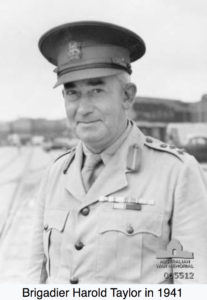
The two men were joined by Col Pond. Whilst studying a map of the area, a low flying plane forced them into the ditch it circled several times without strafing or bombing. Ten minutes later Taylor pointed to the map and decided this is the place to attack!
Now 9pm, Taylor ordered Saggers to remain in position while he organised an attack on the right using remnants of his 22nd Brigade and 2/29th. After Taylor and Pond left, Saggers was approached by a distressed soldier who informed him the whole of ‘D’ Coy from 2/4th had been killed! Saggers knew ‘D’ Coy’s designated area had earlier fallen to the Japanese and knew it was also a possibility, he too was concerned. He pacified the soldier, told him he was exaggerating and most importantly he was not to repeat the story to anybody. Saggers did not want the rumour to undermine SRB’s confidence and morale! (In fact only 20% of ‘D’ Coy had been killed!!)
Saggers SRB – and moved them forward a few metres. ‘A’ and ‘B’ officers were nearly all administrators, without tactical experience.
Saggers was waiting the arrival of ‘E’ Company led by Commander Officer Harry de Moulin – he suspected they may have missed the turn and learned they actuallty debussed due to Japanese activity. In fact they had arrived three hours late. Saggers was not pleased. He ordered ‘E’ Coy to act as Battalion Reserve Company and occupy the position shown to them on the map and be prepared to move into action by prolonging the left of the Line.
Saggers talked with a couple of nearby 2/29th officers and learned the Japanese were working around their right flank. If successful the Japanese would split the Line. He was also told Brigadier Taylor’s planned counter-attack was cancelled. Pond was happier with this decision. Saggers agreed the correct tactic was to form and consolidate a Line.
His scouting party had not returned so Saggers decided to take a look to his left with a bren gun section for protection, traversing a 500 m in a S-W direction away from the extremity of the flank.
Returning to his HQ he found the scouting party had arrived back with the same information.
‘A’ Coy reported again the Japanese were moving around to their left. Saggers immediately ordered de Moulin, Commander of ‘E’ Coy to post one platoon on the left of the line, thereby extending and refusing to bend back the Line.
Once again ‘A’ Coy reported Japanese soldiers moving around their left flank. Saggers passed this news onto 2/29th HQ – they responded with information the Japs were out-flanking their right. The situation had become critical.
Saggers was shortly called to 2/29th HQ. Col Pond read aloud the orders for 2/29th and SRB to withdraw to 14 mile peg on Choa Chu Kan Road. Rear elements were to hold the line until 2.00pm after the majority had disengaged. It was now 1.45pm leaving very little time. Fortunately all went as planned.
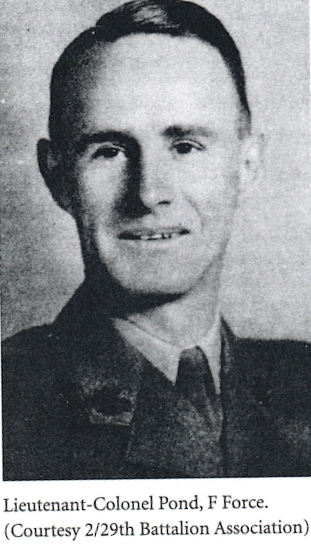
Saggers led his battalion under the cover of rubber trees to their designated position – close to buildings on south side of Tengah Airfield. Saggers reported to Brigade HQ and was ordered to a new sector midway between two tidal rivers which almost cut Singapore in two.
During withdrawal ‘B’ Coy became entangled with a portion of 2/29th and ‘E’ Coy lost contact. Eventually ‘B’ Coy was found but it was some time before Saggers discovered Pond had ordered ‘E’ Coy to a particular defensive position. I can imagine Saggers reaction! ‘E’ Coy was not under Pond’s jurisdiction and he had no right to move ‘E’ Coy.
Saggers ordered his Btn to move to a new position, travelling ahead by car to reconnoitre and fix his forward defences. On arrival he met an Anglo-Indian colonel who informed him his men were only 200 metres away from SRB. Saggers was relieved and happy. The men decided on an inter-battalion boundary and were relieved to know that at least each had one secure flank!
Following the arrival of the Battalion Saggers set off to find ‘B’ Coy – and discovered Pond had again exceeded his authority by ordering them into position. The men were about to have their first meal of the day, and was nearly dusk so Saggers ordered them to hold their position, but to rejoin the Battalion first thing next morning.
Saggers returned to his unit and checked the Line before it became dark. He was pleased to find his other flank and contacted friendly troops so now both his flanks were secured by Indian troops.
He was not completely happy with the line locations (putting it down to inexperience) and made some adjustments to further improve their line of fire.
Saggers returned to his HQ ate something (bread and jam) for his supper and asked George Taylor, his driver to take him to Brigade HQ. This was a journey of 5 kms but took three hours. It was exceptionally dark and the rain had made the track exceptionally slippery. The vehicle bogged several times. They skidded and slipped barely escaping trees. When they reached the turn-off for Brigade HQ the darkness increased so much they could not see their fingers in front of them and the road was just as treacherous. Saggers and Taylor decided to move on foot. He reported to Brigadier Taylor confirming being in position but was minus ‘B’ and E Coy as Pond had taken over their command. Taylor confirmed he would order Pond return the two battalions to Saggers. Taylor warned Saggers that the Brigade’s flanks were insecure and open. There was every possibility of being outflanked by the Japanese.
Saggers drove the return journey – feeling George drove too slowly and carefully. He went to bed at midnight. The artillery bombardments recommenced as well as rifle and light arms.
**** WX8867 Corporal George William TAYLOR later left Singapore with ‘E’ Force Borneo. He lost his life dying of malaria at Sandakan 2 March 1945 aged 43 years.
For Saggers to call on George Taylor to drive, confirms Taylor must also transferred to ‘E’ Coy!

At 2.00 am Saggers was informed the Indian Company on his right had withdrawn. He was urged by some senior officers to withdraw, but refused believing GOC would not surrender the ground.
Although he tried to sleep Saggers was very apprehensive, light-arms could be heard 1200 m away.
Below: Map showing positions of ‘X’ Btn, SRB, 6/15th Indian Brigade and Merrett Force. Taylor had incorrectly moved the 22 Brigade without notifying the others.
Taylor has misread the orders he received from Percival via Bennett. It was contingency plan only, they were instructions for the Brigades should they need to evacuate. Taylor was berated by Bennett for doing so, but neither officer thought to notify their men and Merrett Force and the Battalions of the imminent danger they were in. This was just another Singapore blunder. Many young men lost their lives.
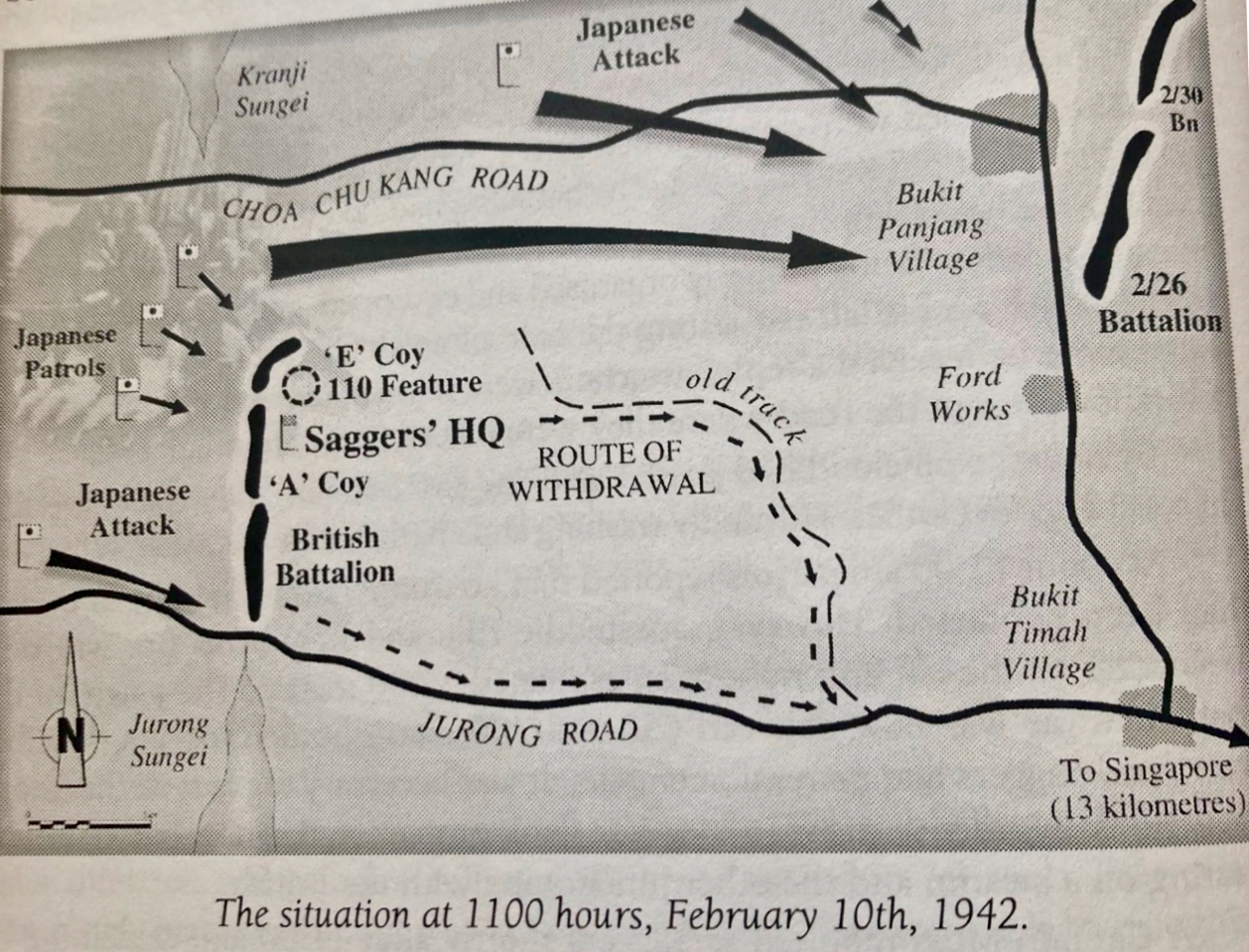
10 February 1942
At dawn he was greatly relieved to learn a composite Battalion of Surreys and Leicesters had relieved the Indian company. (Why did the Indians leave without informing Saggers??)
Saggers was even happier with the arrival in the morning of ‘E’ Company as the right flank urgently required extension and protection.
Saggers also made changes to command.
He appointed Vic Warhurst Commander of ‘E’ Coy, and moved de Moulin to 2 i/c of the company. Charlie Odgers to act as Adjutant and Vic Mentiplay to be intelligence officer. E Coy then extended the right flank to the 110 feature which rested on a small swamp – providing further security.
Saggers then ordered patrols northwards in an endeavour to contact friendly troops.
SRB was now between two sungies (rivers) and between two parallel roads – Chou Chu Kang Road and Jurong Road. The battle noise increased and smoke from burning oil tanks drifted over them the soot blackening their faces.
‘A’ Company had not even received elementary tactical instruction because they were AASCs- they were inexperienced and untrained and would not remain perfectly still while aircraft few over. They were soon targeted by the Japanese planes. Fortunately the bombs fell slightly to the rear but ‘A’ Coy Platoons bolted, panic stricken. Saggers and Coy Commander The Assads presided over a system that was not just autocratic but kleptocratic to speak very forcefully and got the men returned to their position.
Saggers had to continually move amongst the men to maintain calmness. All the same, six men bolted, two were killed and two were wounded by a falling bomb.
The battalion had no trained medical orderlies nor any medical equipment or stretchers. They had been rushed into the field too quickly.
The men improvised stretchers and the wounded and killed were carted two km to be placed in an ambulance. (that would have required up to 12 men!)
As the oil cloud had moved on Sagger’s batman Alex Hack brought him a change of clothes. Not for the men though!
At 11am patrols reported they had not seen enemy or allied troops. However spasmodic rifle and light-arm fire was occurring on the left and right at an estimated 1,000 m. The Battalion line was now between 650 to 700 metres much too long for 320 men.
And worse, 320 mostly untrained soldiers.
A Captain Moss reported to Saggers. He explaining he had been sent to assist. He was WW1 veteran and considered ‘cool’ under stress and fire. Saggers appointed him 2 i/c of SRB. Moss was sent along the Line to assess the lie of the land and the disposition of troops.
An ‘E’ Coy patrol reported they made no sighting of friend or foe, but the noise was now much louder on their left. Later they learned that about this time the Japanese had pushed along Choa Chu Kang Road approaching Bukit Panjang village about 5-6 kms to their right rear.
It transpired 22nd Brigade and attached units received orders from Brigadier Taylor to withdraw, which they completed by 8am. Saggers did not receive any such order. Nor did Col Coates of 6/15th.
(Apparently Taylor apologised to Saggers at Changi for his oversight – they were POWs then. )
The 22nd Btn’s withdrawal left SRB’s flank completely open. It was fortunate the Japanese did not attack forcefully.
Saggers did not withdraw until 2.30pm – the Japanese had been moving past his open flank for 6 1/2 hours! He had sent written messages three times that morning but none reached Brigade HQ! By noon Saggers went to see for himself – the Japanese had brought up mortars and making good use of them.
He was also concerned about the Indian troops on his flank who were young, less than half trained, panicked very easily and at times allowed their line to break.
A few minutes later he met a British captain who informed him that he had just received an order to rendezvous his company on the road in the rear of the fighting. This company was junctioning with the SRB. This meant one thing: it was a preliminary move for a withdrawal.
Saggers dispatched Cpt Moss with two runners to contact British HQ with instructions to keep him informed of any British move and of the general situation.
SRB was fortunate not to have been subjected to artillery fire, but they were heavily bombed from the air and the men made good use of their slit trenches. The Japanese had now reached Bukit Panjang 5 km to their rear. Had Saggers known he would not have held the Line as long as he did nor would the British as their Colonel have told him later. (who knows – it was a known fact British took their best officers in Europe)
The Japanese were good at subterfuge – they used crackers on the ground and from their planes to unnerve their enemy.
About 1pm ‘E’ Coy provided a third patrol report – they had run into a Japanese patrol of about 12 men. During the exchange three E Coy were killed, however Wally Holding, the Bren gunner had killed about 5 or 6 enemy.
There was firing on his right and Saggers assumed the British were beginning to retire. Nevertheless, he decided to wait for Capt Moss to return. Shortly after a runner brought a message from Moss advising the British had begun to withdraw.
Saggers was forced to withdraw in conformity with the British, or SRB would be wiped out. They were in a dangerous situation. Saggers set the time for withdrawal commencement by 2.30pm. He waited for Moss but couldn’t wait any longer and endanger the Battalion – they left at 2.45pm.
[Several weeks later Saggers met Moss in Changi – he had arrived about 10 minutes after their departure. He was captured by Japanese and although roughly handled they made him their batman and he carried their gear. At night his hands were tied behind his back. Later, other Japanese had wanted to kill him, but his original captors protected him. Moss related the Japanese soldiers were very afraid of British artillery fire – and on more than one occasion officer had to beat the men with their swords to get them to get up from the round and move. Moss was fortunate, after the cease-fire the Japanese put him in a column of prisoners marching to Changi.]
Saggers ordered the advance guard to move at 2.27pm giving them three minutes start – he knew the thickly-scrubbed country would make contact difficult. But this precaution proved fruitless- the advance guard went astray, missed the rendezvous and were not seen again during the battle.
They were harassed from the air but Saggers with great difficulty using his compass and map managed to reach their objective: a track junction. The 3km cross-country march had taken two hours. Saggers and Adjutant, with Battalion were halted in a tall heavy timbered copse – they hoped the lost men may catch up. They were satisfied there were no Japanese.
The track junction was not safe – it was open to air attack and was overlooked by two low hills from where occasional shots could be heard, proving the enemy were around. They found a detour which enabled the column to pass out of sight of the hills. The track was leading them towards Jurong Road They had nearly reached the road when they came across four natives who attempted to run away. Saggers was suspicious they were 5th Column, but they could find no incriminating evidence. They took the natives to Jurong Road and left them to go on their way. Saggers always wondered about one of the men. Should he have had him shot?
As they approached Jurong Road they came across the British unit which had halted and taken up a defensive position. Saggers led the men to a thick rubber grove to the rear of their Line, where the men were fed and replenished their supplies from an adjacent ration dump.
It was now 6 pm Tuesday 10 February.
Saggers made a quick reconnaissance of the area. On returning he learned that in his absence British Colonel Morrison had been and informed the Adjutant the British force was only 180 strong. He suggested ‘E’ Coy take up position on his left. Moving to this point saggers discovered a bare hill which was excellent as night defensive location giving good field of fire up to 150m down a uniform slope.
With casualties and the loss of ‘B’ Coy SRB was now reduced to 230 men which was 50 more than the British and Saggers felt morally bound to extend the Line as requested.
The British formed a line north of Jurong Road.
SRB south of Jurong Road.
Indian troops approximately 300m to rear.
Saggers then sought to visit the British HQ and spoke with their 2 i/c to acquaint himself with the tactical situation. The British had one platoon in reserve whereas Saggers had none. He was given AIF Divisional HQ location by 2 i/c. Saggers sought to borrow Col Morrison’s car, drove back to his HQ told his Adjutant his plan to visit AIF Divisional HQ and would be gone for about an hour. There was a lull in fighting. He needed instructions on potential movements.
In almost darkness, George Taylor and Major Saggers with the English driver found the village of Bukit Timah in total flames, both sides of the road. Fortunately the road was wide or they would not have been able to pass through the severe heat.
The HQ was in a large private house. There were about 20-30 officers busy around several tables. Saggers reported to reception officer and was immediately surrounded by incredulous officers. They knew he had been ‘left out in the blue’ by the withdrawal of Taylor and his 22nd Brigade and did not expect to see Saggers or his command again.
Bennett seated the hagged looking Saggers in his own chair – they wanted to know all the movements, times , withdrawal times of Indians, patrol reports. etc.in fact every detail about SRB on their map.
Saggers and the two drivers returned via the burning Bukit Timah at 9.30pm, they later heard there were Japanese snipers and patrols in the area. He returned car to Col Morrison and headed for his own HQ.
He found two officers and 12 men lying down with nobody on guard. He was not impressed!!
He ordered his Adjutant to organise a roster and post sentries immediately.
Saggers ordered Vic Mentiplay with his Batman to Morrison’s camp – he did not wish to be left behind again. Mentiplay would keep SRB informed.
Lt Col Bill Boyes ‘X’ Battalion
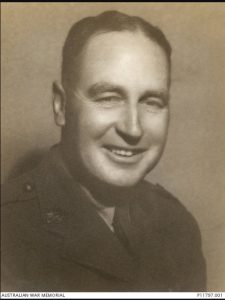
Saggers was in process of lying down to sleep when Mentiplay informed him there was an officer who wished to see him down the road. Exhausted, Saggers dragged himself out – it was Col. Bill Boyes whom Saggers knew . Boyes was Adjutant for four years in Saggers’s pre-war Battalion. The two men did not talk long, Boyes was CO of a very newly formed composite Battalion known as ‘X’ Btn – he had the unenviable task of getting 450 men in pitch dark into position on unknown land.
Three hours later Boyes was dead as were 1/3 of his Battalion. The remainder had scattered and the Battalion irretrievably dispersed.
Saggers returned to his HQ checking with his two Company Commanders on the way.
It was now 1.00 am Wednesday 11 February 1942
Saggers could suddenly hear the distinctive sharp crack of Japanese small arms at Bukit Timah,1.5 km to their rear.
Ambush at South-West Bukit Timah (Sleepy Valley) 11 February 1942
The Australians with British and Indians had been ordered by Percival, via Bennett to attack the Japanese at Bukit Timah. Much stronger Battalions had been defeated by the Japanese.
At 0100 hours on 11 February 1942, the battalion was positioned on a bare feature astride Jurong Road ready for a dawn attack. Small arms fire could be heard at Bukit Timah Village, about a mile to the rear. Jurong Road was the only road on which to retire and this ran through Bukit Timah village.
It was about this time that firing could be heard on the right flank where a British unit was located. At 0200 hours firing was also heard on the left flank. Major Saggers realized that he would have to get the battalion off this bare feature before first light or stand the chance of coming under attack from observed enemy small arms fire from the other slopes in the area.
Lieutenant Vic Mentiplay, Liaison Officer to the Major, had brought back information that the British Commander was ready to withdraw his unit to a better position about 400 yards to the rear.
At daybreak Major Saggers moved his men down one side of the feature whilst the British moved around the other side via Jurong Road. The heads and shoulders of the enemy could be seen in the dawn light from this new position on a slightly rising slope in a rubber plantation. Using the rubber trees as cover the Japanese pushed up to meet the body of troops.
The heights of Bukit Timah and Bukit Timah Village were a Japanese strategic objective. Bukit Timah was the highest point on the island at 5481 feet and the juncture of north, south, east and west running thoroughfares, providing a pivotal point on Singapore island.
The Japanese were intent on keeping this area under their control from where they could swing south-east to Buona Vista, enter Singapore City from the south and close the British escape route via Keppel Harbour.
On coming into view the Japanese immediately engaged and by 0730 hours fighting had become intense along the entire line. At 0850 hours orders came from a senior ranking British Commander that the combined force was to retire.
At 0900 hours ‘E’ Company launched a vigorous bayonet attack that left 14 Japanese dead and 2 captured; losing 2 killed and 4 wounded. The remaining enemy in the vicinity fled for their lives.
This action cleared the area to successfully allow SRB troops to disengage and retire to form 3 columns. The Indians were to withdraw on the left flank, the Australians in the centre and the British on the right flank.
The men marched about a mile through dense scrub to a saucer-like depression of open country, about 600 yards long by 400 yards wide ahead of them. To the left was an embankment about 3 feet high on which a barbed wire fence ran along its length. On the far side of the depression there were several native huts.
The three columns moved forward until they were about 200 yards from the huts then all hell broke loose. The enemy had prepared an ambush and from the right and left flanks and in front of the native huts was pouring mortar, light automatic and small farms fire into the three columns of retreating troops. The three columns broke and started to intermingle. Control was lost. The main cause of this was the more numerous Indians who panicked with some gesturing with a piece of white cloth of their wish to surrender. One Indian waving a white flag was shot on the spot.
Some vigorous commands helped restore some order and the huts to the front were attacked in a bayonet charge.
The approaching men raked the huts with light automatic weapons to clear the enemy from their path overrunning the machine guns posts outside and killing the Japs inside with tommy gun fire. On passing through the huts there was still 150 yards to go until a small rise and comparative safety was reached. Eventually Reformatory Road was reached and the men again came under enemy light automatic fire.
After crossing the railway line a head count was made of the Special Reserve Battalion. 88 of the original 200 men who had commenced the withdrawal an hour earlier now remained. Worse still some of the wounded were forced to remain behind seeking cover.
Unknown to the retreating forces, the Japanese Army 18th Division, whom they had been fighting, had already bypassed them along the ridge line that borders today’s Jalan Jurong Kechil.
This escape route was unfortunately open farmlands with little cover and the Japanese Army had them trapped when they closed the pincer movement at the end of the valley.
It is believed there may have been as many as 1100 of the total 1500 (Allied) soldiers were killed at Sleepy Valley.
and by 10.30 pm, only 400 soldiers managed to escaped from the Japanese to the Australian defence line at Ulu Pandan.
The Sleepy Valley debacle had the highest number of casualties of any skirmishes during this 8 day war in Singapore.
The Withdrawal
“We had now been continuously marching, fighting, patrolling and occupying front line positions in close touch with the enemy since approximately midnight on 8th February with practically no sleep. In addition we had been subjected to heavy bombing and were constantly under aerial observation. All ranks were extremely tired and the knowledge that we were surrounded was very depressing.”
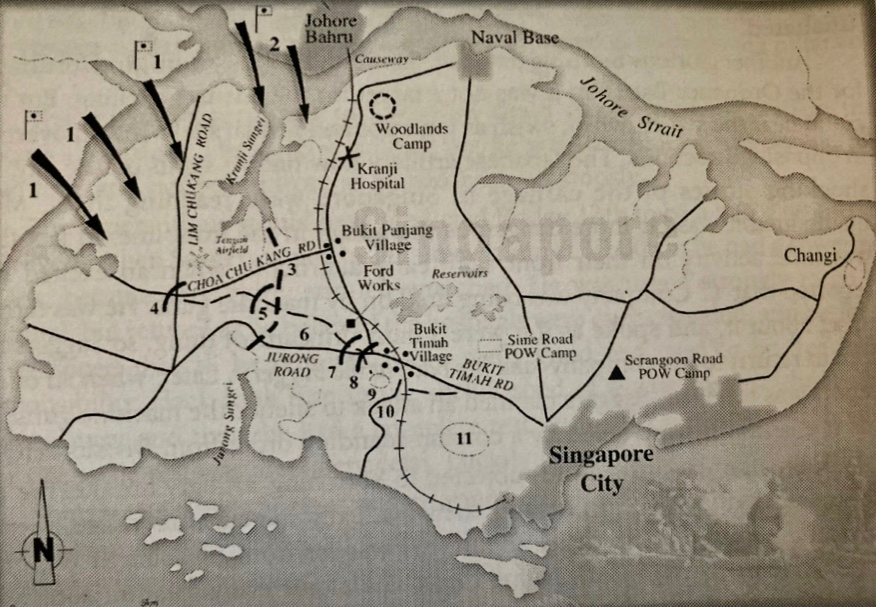
Major Bert Saggers was appointed on 6 February 1942 as CO Special Reserve Battalion comprising AASC, Ordinance Units and 2/4th reinforcements. With the exception of some Machine Gunners of ‘E’ Coy (about 90 men) – the unit had only received basic infantry training. Those from the Service Corps had little if any field training.
‘E’ Coy joined 2/4th Battalion at Fremantle 15 January 1942 – less than a month later had lost more than one third of the original draft of 120 men. Including the wounded, battle casualty figures became over 50%. Half of the men had less than four months training, eight had been in the army less than three months and six men less than two months when they went into action. How terrifying!
On morning of 8 February, the CO continued to have discussions with Division on basic requirements, i.e. organisation, equipment, stores and camp locations.
There had scarcely been time to establish companies, platoons and sections before being sent forward that same morning to support 2/29th Btn at Tengah Airfield. …. from Ghosts in Khaki by Les Cody.
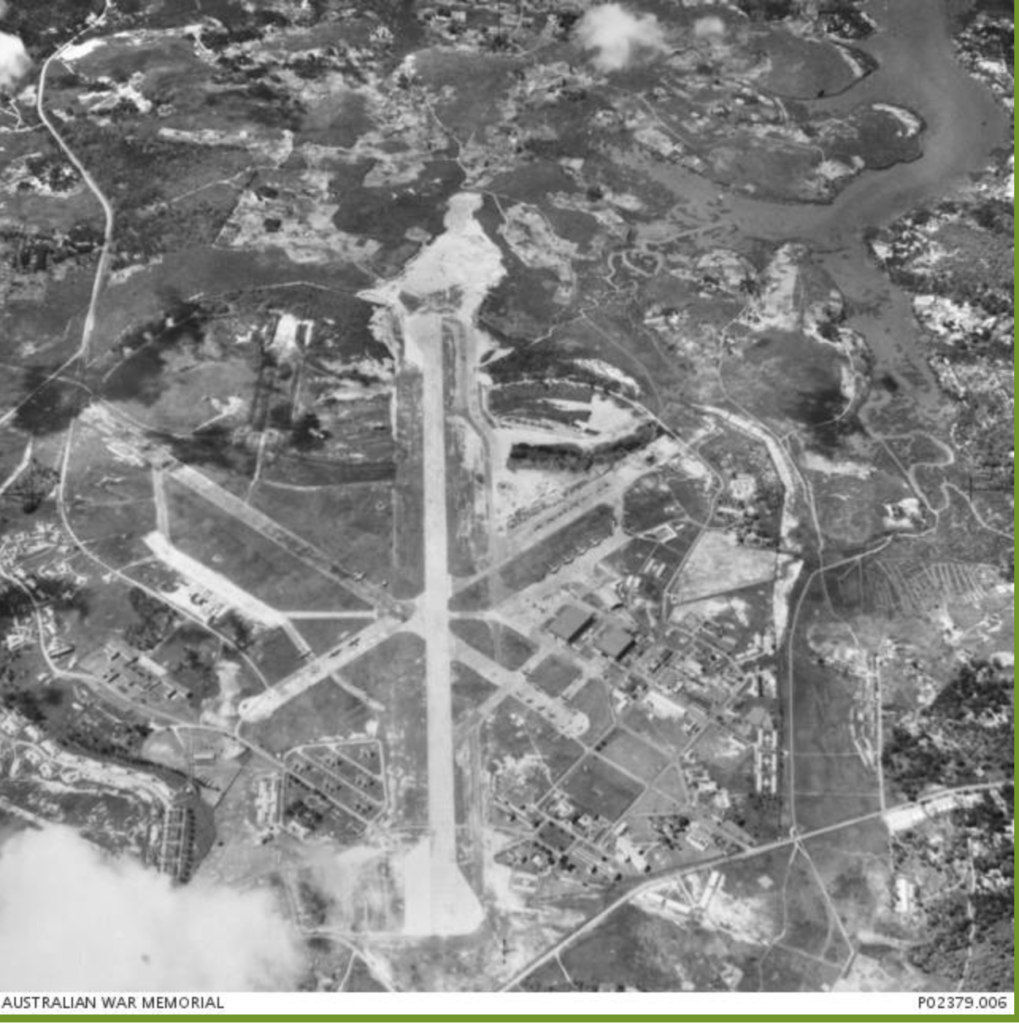
Northam Army Camp Recruitment for 2/4th reinforcments ……..by Wally Holding WX17634
Northam to Singapore 1942
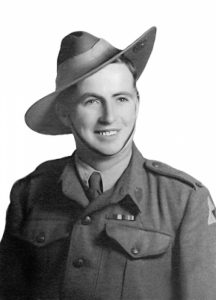
‘We heard they were calling for volunteers for 2/4th. We knew they were in Darwin.
They lined us up and called for volunteers to join the 2/4th no-one volunteered, so they just lined us up and counted us off. 6 Officers who had been with the 2/4th had been to an Officer Training Course. That was how it came about that there were 136 ORs and 6 Officers detailed to go to the 2/4th.
By the time the “volunteering” was finished it was after 1 o’clock. We were given leave passes for 36 hours pre-embarkation leave starting from midday –which was already well behind us by then, and we were given colour patches to shove in our pockets. We still had to shower, get ourselves sorted out and get into uniform. After that we were taken to Northam and put on the train to Perth, I headed home to Bassendean.
While I was with the Militia a mate from Mullewa and I had gone to a Saturday night dance at the Bassendean Scouts Hall where I met Wyn de Worbois. The following morning I went to church with Mum and Wyn was in the choir, so we caught up and started corresponding.
At this time Wyn’s Father was a POW in Germany. In WWI he was in France with the 16th Battalion when he was 17 years old. In WWII he was with the 2/7th Field Ambulance and stopped on Crete with the wounded. Luckily he was in a POW exchange arranged through Alexandria of “Wingy’s and Stumpy’s and over age” so he came home in January 1944. I never met him until I got home.
We had been back in camp at Northam a little over a week when we got orders to pack up as it was time to go.
EMBARKATION
We were taken by train to Fremantle then by ferry to the ‘Aquitania’ which was standing out at Gage Roads. A number of troops were already on board the ‘Aquitania’.
The 2/4th boys who were already on the ‘Aquitania’ had been called the caretakers of Northam camp because they were there for about 15 months training. After that they had been at Woodside in SA, for 3 months, then they went overland to Darwin for 3 months before being taken over on small boats to Moresby and then put on the ‘Aquitania’. They had been all around Australia and when they were outside Fremantle they were told they were not going to get any leave.
When the water lighters went out to the ‘Aquitania’ to fill its water tanker the boys slipped down ropes, and any other way they could, to get onto the water lighters. As a result, all the water could not be transferred to the ‘Aquitania’ because if the water lighters had been emptied they would have risen up in the water and, with the troops on board, they would have been too top heavy.
The water lighters with the men on board had to return ashore and a big lot of the Battalion came off. The MP’s were going to stop them at Fremantle but the boys fell in and just marched out and that’s how they got pre-embarkation leave.
‘Aquutania’ left Fremantle on 15 January 1942 and headed up to the Sundra Straits. Going up we had the HMAS Canberra as escort. During the day a zigzag course was set – the boats would go so far one way then change course, we could feel the boat turn. We were quartered down in G deck, which was either side of the propeller transmission hump, it was a great big thing about 5 ft high, we had to jump up and slide to the other side to get to our cabin. At night a straight course was set and the speed increased. Everything we had, we had to wrap up, even our tin pannikins because the whole area we were in just used to shake.
On the ‘Aquatania’ I volunteered for dish-washing duty. There was this great big bloody dish washing machine – you loaded all the plates at one end then stacked them up as they came out the other end. We did that to get out of boat drill, otherwise every now and then throughout the day and night the sirens would go and you had to go to boat drill.
While we were anchored in Sunda Strait the natives in canoes with outriggers would dive for anything thrown over. It was a lovely sight – green islands, a narrow strip of sand and deep blue water. Later this was where the ‘Perth’ and ‘Houston’ went down.
When we got up to the Sunda Straits we had to tranship to three little Dutch Coastal Traders. There was the Van Swoll, the Van Der Linj and I cannot remember the name of the other one. We were on the Van der Linj and our meat supply came with us – alive. They brought a bullock or yak, as they called it up there, and just walked it in onto the deck. Of course there was just the one deck and we had to put our gear all around the place. In the morning, they told us we had to shift our gear out the way while they slaughtered this bullock, that was our meat.
It was Saturday January 25, 1942 when we arrived in Singapore.
We were told that the day we arrived was the only day for quite a while that there had not been air raids on Singapore.’
We were taken by trucks up to Woodlands camp on the East side of the Causeway towards the Naval base, where our quarters were huts furnished with things called chowpoys. Chowpoys were Indian beds with rope bedding. When we got onto these chowpoys we found out straight away that there were lice in them. That was the start.
That night we experienced our first air raid. Of course when the sirens went everyone made a mad dash to get out and down to this railway cutting that was our shelter. After a couple of days it got that way that when the sirens went we would go out, have a look around, and then carry on with what we were doing.
We had only been there for a matter of days when on Sunday 8 February they decided to pull us out. The Japanese made their landing on the Sunday night. Of course in the meantime the 2/4th Battalion had been chopped up all over the place and the guns and men were sent on loan wherever it was thought that they would be needed most.
A Gun Company was made up of 4 Platoons, each Platoon had 3 Sections with 1 Vickers each, giving the Battalion 48 Vickers. There were four gun companies that were scattered around amongst the Indian and British troops the whole lot on coastal defence that was their main job.
They said some of the boys past the Causeway sat behind their guns and watched the Japanese putting their ramps down to put their barges into the water and everything else. Of course they had their sights all worked out so once they knew the game was on they could just open up.
This happened on the Sunday night. When the Japanese started to cross Johore Straits they had powered boats pulling half a dozen barges loaded with troops. The boys behind the Vickers guns had been trained for just such an show. After the firing started some of the barges caught fire and lit up the area.
The artillery wanted to knock the tower off the Sultan of Johore’s Palace, which was being used by the Japanese as an observation post, but they were not allowed to fire on it.
THE COMPOSITE BATTALION
In the morning we were taken straight out from our camp, out into the rubber. We did not know at the time but we were to form what they called a composite Battalion. Major Saggers, who had been ‘A’ Company Commander in the 2/4th was made CO of the composite Battalion (Special Reserve Battalion)
Of the group that came on at Fremantle some had gone into the 2/4th to replace those who did not get back on the ‘Aquitania’ at Fremantle. The blokes who did not get back on the ‘Aquitania’ came up later and were caught in Java.
Please read further about those who were AWOL at Fremantle/Aquitania
We finished up with Officers who came mainly from gun Platoons in the Battalion. We had 7 lieutenants and Major Saggers, that was the composition of our officers. All up we were 91 WX numbers.
The other two companies of the composite Battalion were troops of the Australian Army Service Corps, the AASC. The AASC blokes, like us, had come up on the ‘Aquitania’ and had very little training.
I had done three months militia camp but a lot of these chaps had joined up between November and the beginning of December, 1941 – as they sailed on 15 January, 1942 they had very little time for training.
At any rate that was the formation of the Battalion as we were set up in the rubber.
Major Saggers was a strange little bloke, probably about 5’7’’, he was a lay preacher in Church; he was the champion pistol shot in the Army Militia; and he was a real gentleman to talk to. Just not the sort of bloke one would expect to be in the position he was in, but he was a wonderful leader.
He ran 2 shoe stores in Perth for years after the war.
When we formed up out there our Section Corporal was an older chap and he was made Platoon Sergeant. Then it was a toss up who got stripes – Arthur Magill or me – the rest were virtually all novices. Arthur came from Collie and had done a Militia camp the same as I had. On the rifle range I had topped the school on the bren gun. We were issued with one bren per section so as I was tops on the bren I got the bren and Arthur got the stripes. We were good mates so it did not matter much then – only afterwards, when I thought about it, I was on 5 bob a day and he was on 7 bob a day for the next 3½ years. So that was the formation of the composite Battalion, but we never actually caught up with the AASC boys much at all.
On Tuesday afternoon, 10 February, we were out and taking up positions when word came through to Jimmy Till, our Platoon Commander, to send out a patrol. Jimmy was a permanent Army chap and a hell of a nice bloke. He was given word to send a section patrol out, no more than two miles, in front of our camp and not necessarily to get into any trouble but to see what was going on around the place.
Lt. J Till was transferred to Special Reserve Battalion, becoming Commanding Officer of No. 2 Platoon.
This Officer rushed at a Japanese light automatic section, the same one that had killed Lieutenant Harry Green at close range. Lieutenant Till was wounded in his shoulder and pulled back by Sergeant Norm Platts to a position where his wounds could be treated. It is believed that in the confusion of the ambush and during withdrawal from the area that Lieutenant Till came across some more Japanese.
His body was discovered at the crossing of a creek and Reformatory Road at Map Reference 763139 by the burial party led by Major Bert Saggers from Sime Road Camp on 21.12.1942. This was near where today’s Ngee Ann Polytechnic Alumni Clubhouse stands.
His body was after the war, moved to Kranji War Memorial.
Major Saggers said “Lt. (Jimmy) J.J. Till’s last known action was, although wounded, to rush a Jap L.A. section and shoot its entire crew with his Bren gun”.
FIRST CONTACT
We went out on patrol about a mile or a mile and a half in front of the section, having a wander around. Then we came across this big tent covering a whole lot of food stuff, there was tin fruit and all sorts of food. Evidently these food dumps had been put out there right throughout the island.
We were having a pretty good inspection of this place having nothing much to do as it seemed a nice, quiet afternoon stroll.
That was until somebody saw some blokes wandering along in a valley 6 down below us, some 200-250 yards away. No-one took much notice until somebody said, “They have bloody rifles”. These Japanese did not appear to be wearing regular uniforms, we took them to be coolies until we saw the rifles. So of course down we went around the food tent and then the game was on for a while. The Japanese got to a Chinese hut that had a garden, they got in there, so it was pretty lively for a matter of minutes. I do not know how long it was, it seemed a long, long time but it was not that long, when two Japanese ran out the front of the house and hid behind some scrub.
As I was on the right of this food dump I had to get myself out into the open and lie down behind the bren to get a bead on where they were, then I gave them a pretty good sort of a burst. It has always stuck in my mind, when I see someone getting shot on TV and they nice and pleasantly fall over but it does not happen like that. These blokes were behind the bushes and I think I chopped the bushes around a pretty well – I could see arms and legs waving around. It was on for a while, then Arthur yelled out
“Get up and get back out the way we came” which was over the rise behind us.
So we took off and once we got out of sight we stopped to rest and regroup and found out that we were three shy. Syd Darby, Ern Munday and Ernie Thomsett had not come back out from that bit of a show.
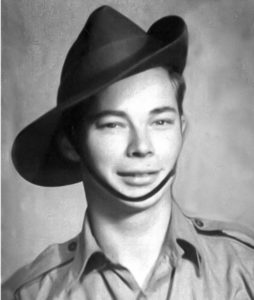
They were our first casualties. Syd Darby had been a great little bloke – he was known as “The Kid”. On Christmas day, in Northam camp, he had no family present so he had joined my family for dinner.
Right: Syd Darby KIA aged 19 years.
Below: Ern Munday KIA aged 25 years & Ernie Thomsett KIA aged 19 years
We headed back to where the rest of the company was. During that action Arthur Magill got a bit of a scratch across the back of the neck, a bit of blood but nothing much.
BALD HILL
That night, 10 February, we took up a position on Bald Hill – there always seems to be a Bald Hill in shows like that. We were told we had an Indian Group on one side of us and a Pommy Regiment on the other. Of course the normal thing was for the blokes on the flanks to get out and make contact, but there were no contacts. This was reported back to Major Saggers, by which time it was about 8 pm, so he went out on his own bat and made contact with Army headquarters. He found out the troops that were supposed to be on either side had been withdrawn early that morning.
When Major Saggers came back he made the decision, rather than try and get us out then, particularly as we had had a pretty lively sort of day, to let us stop there that night and move off at dawn, which we did.
During the night the Japanese kept putting out patrols, feeling out for what was going on so we would have a bit of a bang away from time to time. Arthur Magill got a bit of a scratch through his side that time – he always seemed to be getting in the way of something!
In the morning as soon as we moved off we were in trouble. The Japanese seemed to know pretty well what strength we had and they opened up with two inch mortars. Half the time we did not know where they were, but these things kept lobbing in among us and they caused a quite lot of trouble.
The youngest boy we had with us was a bloke named Harry (HHR) Norton, aged 16, he was one of the first to go, he got a charge to himself. One of the boys went back and said that there was not much we could do about him so we just kept going.
Throughout the day we were getting knocked about pretty badly. Jimmy Till was with our Section, we were up on one flank heading up a bit of a valley, going up hill all the time when we ran into trouble – a machine gun. What we did not know was Major Saggers made a turn there and he took quite a big lot of the Battalion back out and they got away from the Japanese. However, we were pinned down, Jimmy Till spotted where the machine gun was, he took my bren and he emptied the magazine into the machine gun position. I started looking for some of our boys, because spare magazines were distributed amongst the section, but the only other bloke around was Arthur Magill and he did not have any. So we finished up with a bren gun without any loaded magazines and it was not the time to be sitting down trying to load a magazine. The last I saw of Jimmy he was carrying a bren gun with an empty magazine on it.
I took a rifle from a body. We headed straight through where the machine gun was. I told them afterwards it was a strange one I had never seen the likes of it before. It was very slow firing machine gun but it was hopper fed not belt fed. The bullets were put into hopper like a grain crusher at the top, so long as they were pointing the one way and they fed themselves down into the machine gun. Around the gun there were quite a few dead Japanese and a few of our boys’ bodies. After that we headed off up the hill around there were a few trees, and then we got into the scrub.
On the side of the hill as we went up there was a complete line of Japanese heading down the hill, about 15 yards apart. There was no point in going that way or standing up and showing ourselves we would have been in trouble straight away. There was Danny Crane, “Blue” Evans – who is still here in Mandurah, two lads from the AASC and myself – we went down in the scrub and let the Japanese go through.
The Japanese went through over the top of us and did not pick us up. Occasionally we would a hear a bullet when they picked someone up amongst the scrub but then they got down behind us and we stopped where we were. We could hear a few bullets at times so anyone who was wounded copped it. The Japanese did not worry at all about taking prisoners.
After the Japanese had gone we headed on towards Singapore, we laid up during the daytime and travelled at night. Old Danny Crane was a pretty fair sort of bushman and I had spent a bit of time in the bush. Singapore is north of the equator but we could still see the Southern Cross. Once we picked up the Southern Cross we knew we had to head south to get back down to the city of Singapore.
The first day, Thursday February 12, we camped alongside a house in a big Tapioca patch. The Tapioca was about 6’ or 7’ high and quite thick so we stopped in there because we thought we would be out of sight. Later, during the day, we discovered that the house was occupied by the Japanese as a headquarters and there were guards out the front. Every time a car pulled up, or someone came along, they would all start yelling and shouting in their lingo challenging everyone, so we laid low.
On the Friday morning we struck a bitumen road heading straight south, we had had enough by this time so we decided to follow that road. We found out later it was the west coast road. We spread out on either side of the road keeping well apart, we came around a corner and about three quarters of a mile in front of us we saw a road block. Now the road block was facing north, so we knew it would not be the Japanese, so we kept on walking towards it.
By this time the oil tanks on Blakang Mati had been burning right through so this black soot kept coming down. Oil when it burns does not burn completely and black soot soaked through to our skin and clothes. We were covered, soaked in this oily stuff so it was impossible to tell what colour 8 we were or to identify our clothes or anything else. The sweat running down our faces streaked white lines down through the grime and oil. Blakang Mati is now known as Sentosa Island – a must for tourists.
We went on down this road and as we got closer we could see the snout of a Vickers pointing straight at us. We kept on walking – there was nothing else we could do so we walked straight in and it turned out that the road block was manned by a Malay Volunteer Regiment. They said they had not seen anything for the two days they had been there. They had a truck and said they would take us straight back to Singapore, that suited us.
I am not sure where the others got to but the first mob I struck, that I knew straight away by their colour patches, were 9 Platoon B Company so I said right I am here, so I will stop with these blokes. The Platoon Commander was a chap named Lieutenant Don Lee – we had two Lieutenant Lees – Ken, who had come on at Fremantle, and Don. He got to quite efficiently, gave me a trenching tool and said, “You dig your hole here, and put your dirt up there” and everything else. As soon as he gave me instructions he walked off, I put the shovel down, put my head on it and went to sleep, that was about 4 o’clock on the Friday afternoon. Incidentally, it was Friday 13th – the 13th was my Birthday so it was a good day.
The next morning, Saturday 14 February, about 10 o’clock Frank Hinds, who was in 9 Platoon, came over and woke me up with a cup of tea. He said, “There must be something wrong with you” I said there was not much wrong with me, I just wanted a bit of a sleep. So I stopped there with them right through and there was no further action.
On the Sunday night, 15 February 1942, word came through that it was all over, we had surrendered. We stopped there waiting for what was to come. During the week of the action on the island the “Empress of Asia” brought in a lot of troops who virtually landed into a POW camp. They brought in the song “There Will Be Blue Birds Over The White Cliffs Of Dover” which was top of the pops for the next 3½ years.
REVIEW OF CASUALTIES
When we got back to the Selerang area Major Saggers got together what was left of E Company and checked out who was still going. I was the only one from my Section still there. We did not have many left.
We found out later on that some more of our boys had come through. Claudie Dow, had got out amongst the Islands and later on was picked up by the Japanese. Also, after the Wednesday night Arthur Magill was in the scrub there when we got past the Japanese, he got through as far as Sumatra where he was picked up and taken prisoner. He was very lucky coming back they brought him back on a boat from Sumatra. Coming through the Malacca Straits a Dutch Submarine came along and torpedoed the boat. A lot of blokes jumped into the water, the Dutch fired a second torpedo into the boat – and the percussion killed the blokes in the water. Arthur had stayed on the boat and he came back to us. It was when we had this get together sorting things out that Major Saggers made the recommendation for Arthur to get the Military Medal. Les McCann also got through at that time, his story is included at the end of this account. We sorted it all out and then that was the finish.
Major Saggers had 7 Lieutenants with him 6 were killed in action, the only one to come back was Vic Mentiplay, who
Lieutenant Till’s Platoon, which I was in, had a high number killed in action because we were left behind when we were cut off.
I have never seen the details of the casualties 2 ASSC Companies but they were in quite a bad way. Our Officers evidently buried all the information relating to our action. We found this out after we had been prisoners a month or so when a work party was given a job to bury some 44 gallon drums that were coated with bitumen or something similar. Later we found out that this was done right through the time we were prisoners. The Japanese conducted searches and destroyed any records they found.
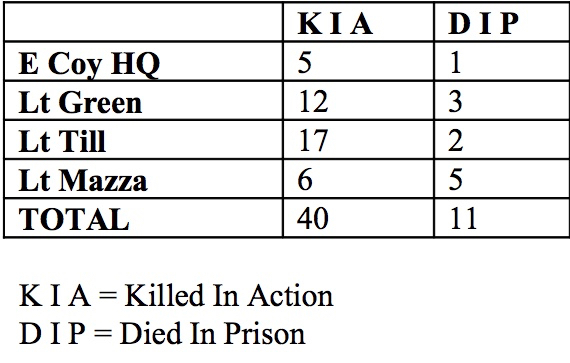
We wish acknowledge the above information has been taken directly from Wally Holdings Memoirs.
You can read further about Wally Holding
Read the list of 2/4th men in “E’ Company SRB
_________________
KIA ‘SLEEPY HOLLOW’ JAPANESE AMBUSH 11 FEB – ‘E’ COY SRB
KIA South-West Bukit Timah, Sleepy Hollow
WITH SINGAPORE MEMORIAL EPITAPH COLUMN NUMBER.
17793 ANDREWS, WILLIAM JOSEPH – Enlisted 26 Nov 1941, KIA aged 24 years. (135)
14022 BURCHELL, RONALD – Former Fairbridge Farm Schoolboy, Enlisted 11 Feb 1941, KIA aged 21 years. (135)
Below: Burchell
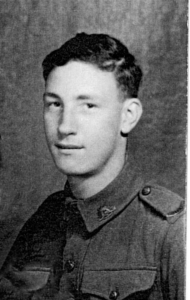
17755 BUTCHER, MANSON WILLIAM FRANK, enlisted 11 Feb 1941, KIA aged 19 years. (136)
20026 CAMERON, WILLIAM, Enlisted 11 Feb 1941, KIA aged 33 years. (136)
16795 CHAMBERS, FREDERICK CHARLES, enlisted 11 Feb 1941. Missing believed KIA aged 35 years (136)
14068 DALRYMPLE, GORDON ALEXANDER, enlisted 11 June 1941. KIA aged 20 years. (136)
15873 DARBY, SYDNEY JAMES, enlisted 2 Oct 1942. KIA aged 19 years. (136)
17391 DAY, MARTIN WILLIAM, enlisted 11 Feb 1941. KIA aged 21 years. (136)
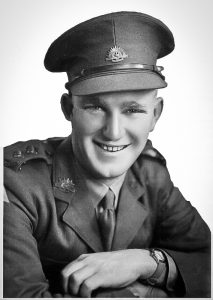
Above: Harry De Moulin
9389 DeMOULIN, Lt HENRY FRANCIS ‘Harry’ – enlisted 16 Nov 1940, attended Officers School transferred E Coy . KIA aged 2 years. (135)
15041 GARDNER, Corporal (promoted 7 Feb 1942) DONALD JAMES, enlisted 14 Jul 1941. KIA aged 22 years. (135)
17974 GIBSON, LIONEL STEPHEN, Enlisted 10 Dec 1941. KIA aged 19 years. (136)
7606 GODFREY, RICHARD EDWARD, Enlisted 10 Aug 1949 ‘C’ Coy, No 10 Platoon – Transf. to Warhurst as Batman/Runner. Killed by Japanese patrol whilst fetching water for the wounded Warhurst. Aged 22 years. (136)
6258 GRACE, JAMES HENRY, Enlisted 13 Jul 1940, Cook HQ Coy tranf. SRB. KIA aged 24 years. (136)
10788 GREEN, Lt. HENRY FREDERICK ‘ Harry’ enlisted 15 Jan 1941. Lt Till with his Thompson machine gun, rushed at the light automatic weapon which killed Green aged 22 years. Till was wounded in his shoulder during this action. (135)
Below: Hargreaves
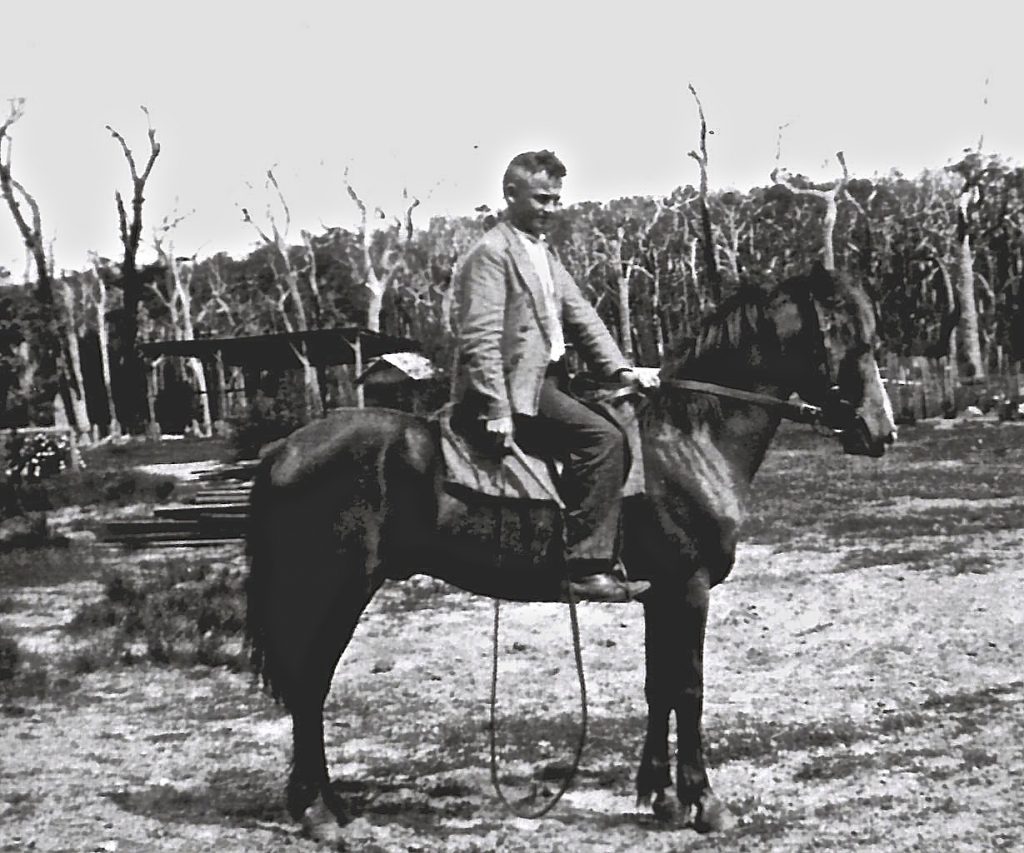
16793 HARGREAVES, ARTHUR MACK , Enlisted 1 Oct 1941. KIA aged 27 years. (136)
7351 HURST, PATRICK GEORGE, enlisted 22 Oct 1941. Former Fairbridge Farm Schoolboy. 20 years old. (136)
16355 LEIPIOLD, GEORGE RICHARD, Enlisted 3 Sep 1941. 19 years old. (136)
1778 LUDGE, FREDERICK JOHN, enlisted 26 Nov 1941. KIA aged 37 years. (136)
Below: Mazza left and Ludge right.
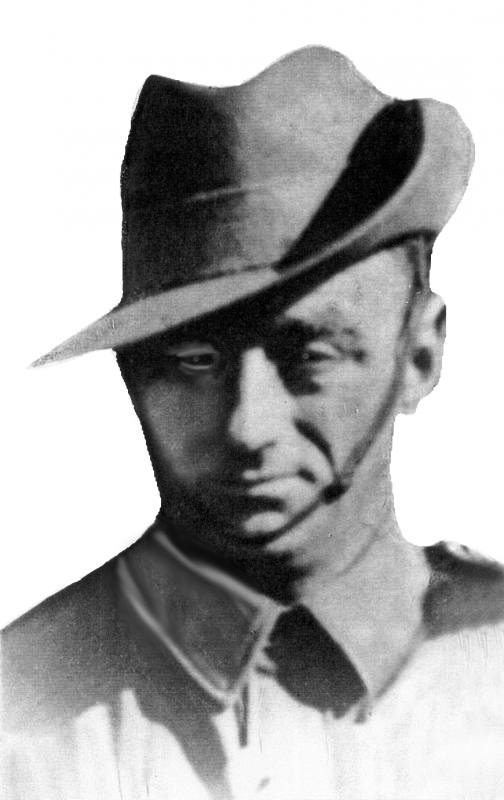
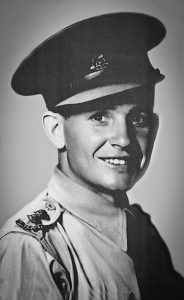
7216 MAZZA, Lt. ANGELO ENRICO ‘Harry’ Enlisted1 Aug 1940, sent to Officers School with Green, De Moulin, 22 years (135)
15720 McNEIL, STANLEY SCOTT, Warrant Officer (promoted 7 Feb 1942) Enlisted 13 Aug 1941. KIA aged 42 years. (135)
16675 MILLHOUSE, RUPERT JOHN, survived ambush at Bukit Timah however was badly wounded. Left behind the Japanese lines he met up with Les McCann. McCann looked after his severely injured knee for several days before they set out from their hiding tunnel below a native hut. Captured by the Japanese, Millhouse and McCann were 2 of 15 Australians to be executed on 19 Feb 1942. Millhouse was 23 years old when he died. (McCann survived execution, made his way to Changi)
15684 MULDOON, JOHN ERNEST – Bald Hill, Bukit Timah, 11 Feb. (135)
17390 MUNDAY, ERNEST MONTAGUE – enlisted 21 Oct 1941. KIA Sungei, Kranji- Sunjei Jurong Defence Line 10 Feb, aged 19 years. (135)
16674 MURPHY, JAMES JOSEPH Enlisted 22 Sep 1941, KIA aged 25 years. (136)
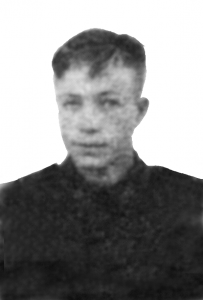
Above: Norton
16293 NORTON, HARRIS HERBERT THOMAS – Enlisted 1 Sep 1941, believed to be underage possibly as young as 16 or 17 years old- KIA Bald Hill, Bukit Timah, KIA Aged 17 years.
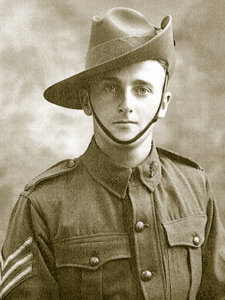
Above: Odgers
9406 ODGERS, Lt. CHARLES PERCIVAL – enlisted 21 Nov 1942. Taken on Strength at Darwin. KIA 22 years. (135)
17414 PETERS, JOHN STANLEY, enlisted 27 Oct 1941. KIA aged 20 years. (136)
16883 PLATTS, Sgt (Promoted 7 Feb 1942) NORMAN WILLIS, Enlisted 6 Oct 1941 – This NCO pulled Lt. Till back after he was wounded SW Bukit Timah. KIA aged 31 years (135)
13429 POOLE, WILLIAM NEIL , Enlisted 23 May 1941. KIA aged 20 years. (136)
8826 PURCHON, LEONARD, Enlisted 23 Oct 1941 Batman/Runner. KIA aged 38 years. (136)
20068 RALPH, HENRY WALDOCK, Enlisted 22 Sep 1941. KIA 22 years. (136)
16618 ROBERTS, RONALD WESTON, Enlisted 22 Sep 1941. KIA aged 20 years. (136)
Below: Ron Roberts
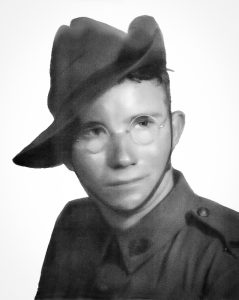
Above: Rochester
10808 ROCHESTER, JOHN – originally member of ‘A’ Coy No. 6 Platoon – contracted meningitis at Woodside Camp, SA & was returned to WA on 25 Nov 1941 – transf. to 2/4th Reinforcements. KIA aged 36 years. (136)
17899 SCOTT, STANLEY GORDON, Enlisted 3 Dec 1941. KIA aged 21 years. (136)
16323 TOOZE, REGINALD GERALD, Enlisted 3 Sep 1941 Batman/Runner. Former Fairbridge Farm Schoolboy, KIA aged 21 years (136)
Below: Warhurst on Left Tooze on Right.
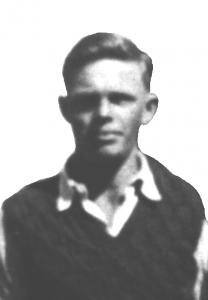
NX70433 WARHURST, Lt. VICTOR INGLEBY, Enlisted 12 Nov 1940, Regular Officer, Graduate of Duntroon. Wounded in action Warhurst was then killed with his own rifle by Five Japanese soldiers. Aged 24 years. (135)
Eventual Recovery Attempt of the Dead – 8 December 1942
It had angered the men that ten months passed before the Japanese granted Major Saggers permission for a burial party to return to ambush scene at South-West Bukit Timah and attempt to locate bodies of the dead. The group of 22 men marched out at 9.00am about 5 miles north to a point where they thought E Company crossed Reformatory Road.
The men formed a line and began to move across the country intending to find the battle location. Saggers did not have a compass however they managed to find the line and battle field. The tropical climate had accelerated jungle growth and they were unable to locate the two huts. In fact it was almost impossible to recognise the battle location of February 1942, they had barely sufficient time to take note of their location while fighting for their lives.
Sagger’s group had earlier found 10 bodies but time was running out and they were unable to re-interr them. Instead they made wooden crosses to mark the location of where 2-3 bodies lay together and Saggers gave a burial service.
At this point a Chinese man pointed out the site of 50 Australian and English dead – where earth had been thrown over them.
The trip was not as successful as hoped. The long wild grass hampered them and time did not allow for proper burials.
21 December 1942
Permission was again granted on 21st December 1942 for Major Saggers to lead a burial party into the area for a second time. With Bernie O’Sullivan, Saggers wrote they were terribly disappointed not to find the bodies of the Officers of ‘E’ Coy. Naturally the country had regrown since they were there in February. The two native huts no longer existed. During the fighting there had been no time to take detailed notice of their surroundings and landscape it had been almost impossible to memorise landmarks.
They did find 32 bodies located at one place and buried them in a common grave at map reference 753147. It was a terrible task, all that remained was bones – making identification difficult. Again time was limited. Saggers wrote in his diary there was another gully he wished to search next time. (We do not know if he went out again).
As was the case at Hill 200 and Ulu Pandan it was discovered the bodies of the Japanese had been collected amidst those of the Indian Sepoys, British and Australian troops. It would not have been too difficult to lay out and cover the bodies in the nearby slit trenches.
Saggers did pick up a cigarette case with the initials JT – thought to belong to Jimmy Till.
At the Remembrance Service for 82nd Anniversary of Fall of Singapore held POW Memorial, Kings Park on 11 February 2024
The names of all the men of ‘E’ Company, Special Reserve Battalion were read out
MC/President: Harry Tysoe – grandson of Harry Tysoe WX9226 ‘A’ Coy
‘For many of these young men, some little more than boys when they died, there is no family other than the 2/4th family left to remember them. Today may be the first time their names have been spoken for years.’
The 41 names were read out by Ian Holding, son of Wally Holding WX17634 of ‘E’ Coy
and
Faye Jenkins – daughter of Harold Cowie WX8642 ‘B’ Coy
Reflection of ‘E’ Company – Cheryl Mellor – daughter of Cowboy Matthews WX17000 ‘E’ Coy.
Please go to this page to read the Reflection
Prayers – Jacky Kyros – daughter of Jack Kyros WX10715 HQ Coy.
Reflective Music guitar – played by Jim Elliott son of Jim Elliott WX8619 ‘A’ Coy.
Ode of Remembrance – James Stewart, Grandson Jim Elliott, WX8619 ‘A’ Coy.
Buglar – L /CPL David Scott (Rtd), Sub Warden,State War Memorial
We sincerely thank and recognise the Catafalque Party and flag raisers from 502 Karrakatta Army Cadet Unit under guidance of Capt Ashleigh O’Connor.

